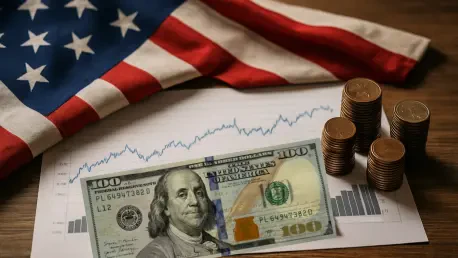As the U.S. economy navigates a complex landscape in the current year, a recent forecast from a prominent economic research institution paints a picture of cautious optimism mixed with tangible risks, raising critical questions about the future. The analysis suggests a modest GDP growth rate of just 1.0% for the third quarter, signaling a slowdown that raises concerns about the potential for stagflation—a troubling combination of stagnant growth and persistent inflation. With labor market dynamics showing cracks beneath a historically low unemployment rate, and external pressures like tariffs looming large, the economic outlook is far from certain. This scenario sets the stage for a deeper exploration of whether the nation is inching toward a stagflationary environment, where slow growth and rising prices could challenge policymakers and businesses alike.
Economic Growth and Inflation Pressures
Slowing Growth Amid Policy Challenges
The economic forecast highlights a noticeable deceleration in growth, with projections indicating a significant weakening through the winter months. Factors contributing to this slowdown include the expiration of electric vehicle tax subsidies and the anticipated impact of higher tariffs, which are expected to increase costs and curb consumer spending. This pull-forward effect on consumption into the third quarter may temporarily mask deeper issues, but the underlying trend points to a contraction in non-AI-related capital expenditures. Such stagnation in investment could push net investment into negative territory, signaling broader concerns for economic vitality. While a recovery is projected by mid-2026, with GDP growth expected to reach 2.0% by the fourth quarter of that year, this hinges on effective stimulus measures and a resolution of trade-related headwinds that currently dampen the outlook.
Persistent Inflation and Stagflation Risks
Inflation remains a stubborn challenge, with the forecast describing a “stagflation-lite” environment characterized by modestly elevated prices and unemployment. This delicate balance poses a dilemma for the Federal Reserve as it shifts toward monetary easing in an effort to stimulate growth without exacerbating price pressures. A more severe stagflation scenario looms as a risk if external factors, such as political interference with the Fed’s independence, come into play—though this is not the baseline expectation. The interplay between inflation and sluggish growth creates a tightrope for policymakers, who must navigate these dual threats without triggering a deeper downturn. The forecast underscores that while a full-blown recession is not anticipated, the potential for economic stagnation paired with rising costs cannot be dismissed, particularly if consumer confidence wanes under the weight of higher living expenses.
Labor Market Dynamics and External Influences
Signs of Weakness in Employment Trends
Despite a historically low unemployment rate of 4.3%, the labor market reveals underlying vulnerabilities that could signal trouble ahead. The forecast points to a declining labor supply, partly due to restrictive immigration policies, alongside a drop in nonfarm payrolls observed earlier in the year. Job growth appears concentrated in specific sectors like education and healthcare, which masks broader weaknesses across other industries. Projections suggest a further softening through the current year, with unemployment expected to peak at 4.6% in early 2026 before a gradual recovery takes hold in late 2026 and into 2027. This trajectory indicates that while the labor market remains resilient on the surface, the cracks beneath could widen if economic pressures intensify, potentially contributing to a stagflationary environment where job growth fails to keep pace with inflation.
External Factors Impacting Stability
Beyond domestic labor concerns, external factors such as tariffs are poised to exert additional strain on the economy. These trade policies are expected to raise costs for businesses and consumers alike, reducing consumption and further hampering non-AI capital expenditures during the colder months. The forecast also notes the negligible impact of the ongoing government shutdown on overall GDP projections, as historical data suggests such disruptions often result in short-lived losses that are recouped in subsequent quarters. However, a prolonged shutdown could alter this assessment, particularly in the current political climate where threats to federal workers add uncertainty. Senior economists emphasize that while these external influences are not currently central to the baseline outlook, their potential to disrupt economic stability remains a critical consideration for the near-term trajectory.
Navigating the Road Ahead
Reflecting on Economic Vulnerabilities
Looking back, the economic landscape revealed a delicate balance between resilience and vulnerability, as modest GDP growth and persistent inflation defined much of the discussion. The labor market, though seemingly strong with low unemployment, showed early signs of strain that could have deepened without timely intervention. External pressures like tariffs and temporary government disruptions added layers of complexity, reminding stakeholders of the interconnected nature of policy and economic outcomes. The cautious optimism of the forecast was tempered by the acknowledgment of risks, including the specter of a more severe stagflation scenario that, while not the primary expectation, lingered as a possibility throughout the analysis.
Charting a Path Forward
Moving into the future, policymakers and businesses must prioritize strategic responses to mitigate the risks of slow growth and rising prices. Strengthening the labor market through targeted policies, alongside careful management of trade impacts, could help stabilize the economy. Additionally, safeguarding the independence of monetary authorities will be crucial to balancing inflation control with growth stimulation. As recovery is anticipated in the coming years, sustained efforts to bolster consumer confidence and investment will lay the groundwork for a more robust economic rebound. Addressing these challenges head-on offers a pathway to navigate the uncertainties and build resilience against potential downturns.









